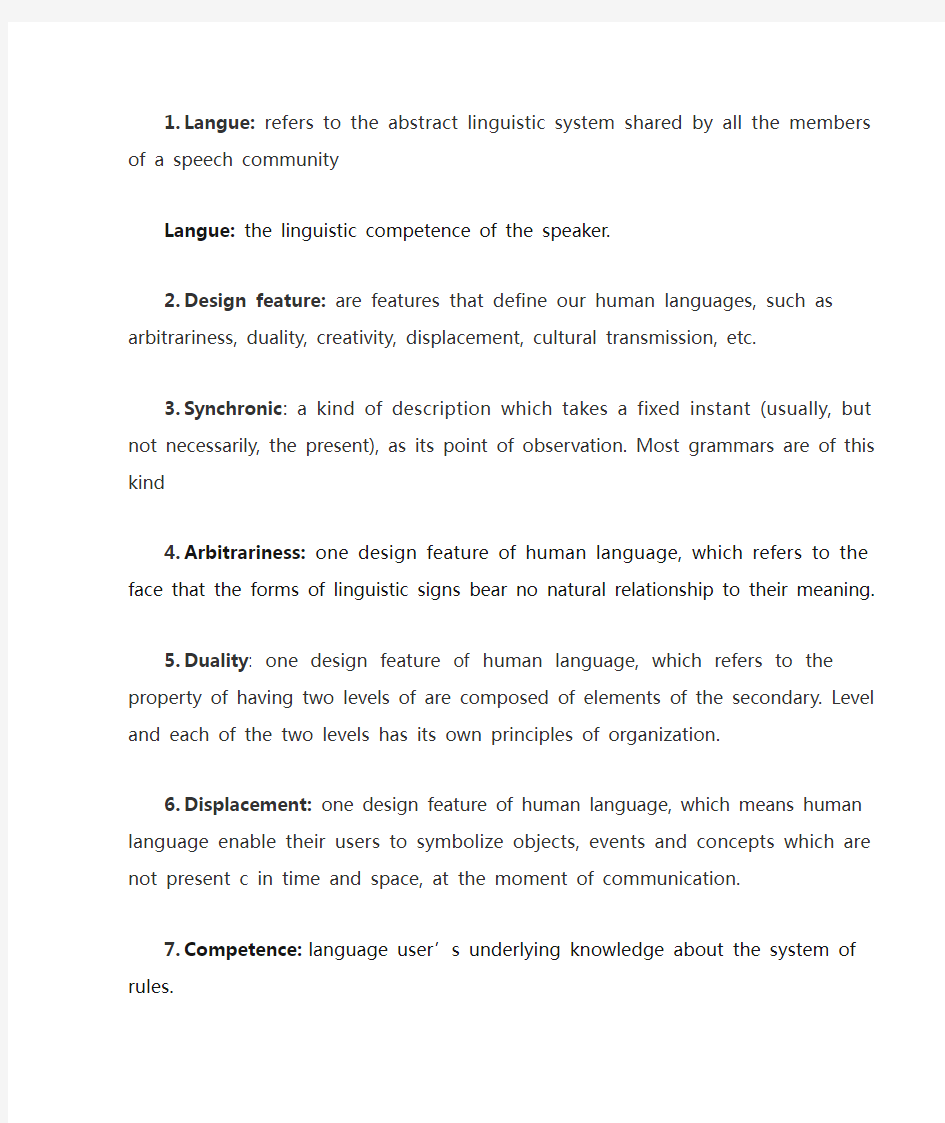语言学必考名词解释

- 1、下载文档前请自行甄别文档内容的完整性,平台不提供额外的编辑、内容补充、找答案等附加服务。
- 2、"仅部分预览"的文档,不可在线预览部分如存在完整性等问题,可反馈申请退款(可完整预览的文档不适用该条件!)。
- 3、如文档侵犯您的权益,请联系客服反馈,我们会尽快为您处理(人工客服工作时间:9:00-18:30)。
ngue:refers to the abstract linguistic system shared by all the members of a
speech community
Langue: the linguistic competence of the speaker.
2.Design feature:are features that define our human languages, such as
arbitrariness, duality, creativity, displacement, cultural transmission, etc.
3.Synchronic: a kind of description which takes a fixed instant (usually, but not
necessarily, the present), as its point of observation. Most grammars are of this kind
4.Arbitrariness:one design feature of human language, which refers to the face
that the forms of linguistic signs bear no natural relationship to their meaning.
5.Duality: one design feature of human language, which refers to the property of
having two levels of are composed of elements of the secondary. Level and each of the two levels has its own principles of organization.
6.Displacement:one design feature of human language, which means human
language enable their users to symbolize objects, events and concepts which are not present c in time and space, at the moment of communication.
petence:language user’s underlying knowledge about the system of rules.
8.Prescriptive: the study of a language is carried through the course of its history.
Prescriptive: a kind of linguistic study in which things are prescribed how ought to be, i.e. laying down rules for language use.
9.Phoneme:the abstract element of sound, identified as being distinctive in a
particular language.
10.Assimilation:the change of a sound as a result of the influence of an adjacent
sound, which is more specifically called.”contact”or”contiguous”assimilation. 11.Connotation: a term in a contrast with denotation, meaning the properties of the
entity a word denotes.
12.Reference: the use of language to express a proposition, meaning the properties
of the entity a word denotes.
Reference: the use of language to express a proposition,i.e. to talk about things in context.
13.Sense: the literal meaning of a word or an expression, independent of situational
context.
14.Linguistic determinism: one of the two points in Sapir-Whorf hypothesis, i.e.
language determines thought.
15.Parole: the actual phenomena or data of linguistics (utterances).
16.Interlinguage:the type of language constructed by second or foreign language
learners who are still in the process of learning a language,i.e.the language system between the target language and the learner’s native language.
17.Transfer: the influence of mother tongue upon the second language. When
structures of the two languages are similar, we can get positive transfer of facilitation; when the two languages are different in structures, negative transfer of inference occurs and results in errors.
18.Perlocutionary act: the act performed by or resulting from saying something, it’s
the consequence of, or the change brought about by the utterance.
19.Hyponymy: a relation between tow words, in which the meaning of one word (the
superordinate) is included in the meaning of another word(the hyponym)
20.Allophone: any of the different forms of a phoneme (eg.
/t/in English. When /t/occurs in words like step, it is unaspirated 21.Error analysis: is the process of determining the incidence, nature, cause and consequence of unsuccessful language 22.Utterance: 1.A spoken word, statement, or vocal sound 2.The action of saying or expressing something aloud the simple utterance of a few platitudes 3.An uninterrupted chain of spoken or written language 23.Interference: a process more commonly known as negative transfer, which occurs when an L1 patter is different from the counterpart pattern of the target language. 24.Predication analysis: is a way to analyze the meaning of sentences. A sentence, composed of a subject and predicate, is a basic unit for meaning analysis is called predication, which is the abstraction of the meaning of a sentence 25.Cohesion: refers to the way in which text “hang together”; to the resources within language that help relate ideas and information and make links between different parts of a text 26.Polysemy: words have two or more than two senses 27.Speech act: refers to an action performed by the use of an utterance. 28.Linguistics: generally, it is defined as the scientific study of the language 29.Phonetics: is the study of production of speech sounds 30.Semantics: is generally defined as the study of the meaning of linguistic units. to be more specific, the meaning with which linguistists are concerned is defined as linguistic semanticsand
